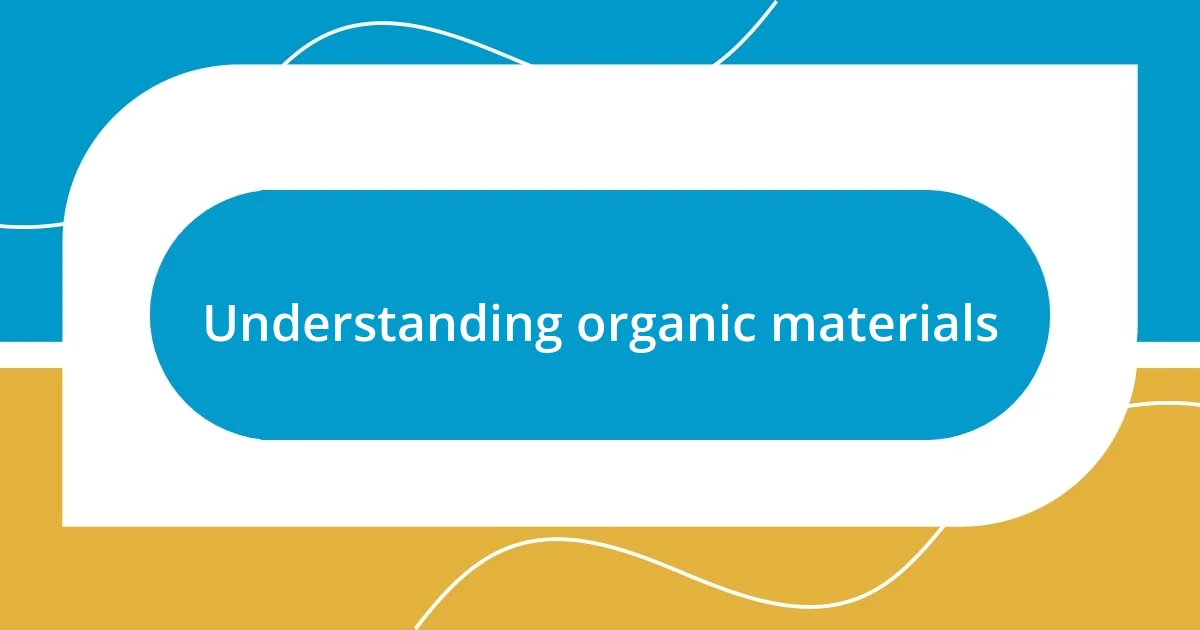Key takeaways:
- Organic materials, including kitchen scraps and yard waste, enhance soil health, moisture retention, and biodiversity, creating a thriving ecosystem for plants.
- Key practices such as layering in composting, using “starter” compost, and vermicomposting boost microbial activity and nutrient availability.
- Sustainable practices like composting, planting cover crops, and applying mulch contribute to reducing waste and improving soil quality, fostering a healthy environment.

Understanding organic materials
Organic materials are fascinating because they stem from living organisms. This broad category includes everything from plant matter to animal products. I still remember the first time I dug my hands into a rich compost pile and felt the warmth of decomposing organic matter; it was a revelation of how life nourishes new growth.
As I explored further, I discovered the crucial role these materials play in sustainability. They not only enrich our soil but also contribute to a vibrant ecosystem. Have you ever noticed how a garden flourishes with compost? It’s like watching a magic trick unfold; the transformation of scraps into life-giving nutrients is nothing short of miraculous.
Understanding organic materials isn’t just about science; it’s a journey into the depths of our relationship with nature. Each time I see the results of my efforts, it triggers a profound sense of connection. How can something that seems so ordinary, like kitchen scraps, lead to extraordinary blooms and healthy plants? It all emphasizes the importance of embracing organic materials in our daily lives for a healthier planet.

Benefits of organic materials
Organic materials come with a treasure trove of benefits, especially when it comes to soil health. From my own experience, watching my garden thrive after incorporating compost was a game changer. It’s not just the plants that flourish; the soil becomes a living entity, teeming with beneficial microorganisms that break down nutrients and make them accessible to plant roots. Have you ever seen the difference a handful of rich, organic matter can make? It’s like giving your plants a boost of energy, and honestly, it feels good knowing I’m working in harmony with nature.
In addition to enhancing soil fertility, organic materials also improve moisture retention. I remember a particularly dry summer when my garden relied heavily on organic mulch. It kept the soil cooler and retained water, allowing my plants to thrive despite the heat. This sustainable approach not only saves water but also minimizes the need for chemical fertilizers, creating a healthy cycle of growth. It’s a win-win situation for both my garden and the environment.
Moreover, using organic materials supports biodiversity. My foray into creating a compost bin opened my eyes to how diverse organic waste can be. Everything from fruit peels to coffee grounds transforms into a nutrient-rich resource. While collecting those scraps, I also learned how this practice attracts helpful insects like earthworms. These creatures further improve the soil, making gardening a collaborative effort. It’s fascinating to witness how something as simple as reusing organic waste develops a thriving ecosystem right in my backyard.
| Benefit | Description |
|---|---|
| Soil Health | Enriches soil with nutrients and beneficial microorganisms. |
| Moisture Retention | Improves soil moisture retention, reducing the need for watering. |
| Biodiversity | Supports beneficial insects and promotes a thriving ecosystem. |

Sources of organic materials
In my journey to find sources of organic materials, I’ve come to appreciate the numerous options right at my fingertips. For instance, scrap vegetables from my kitchen or the remnants of my Sunday roast have become valuable assets. I can still vividly recall the pride I felt when I turned my kitchen waste into nourishing compost. It sparked a deeper curiosity about where else I could source organic materials.
Here are some excellent sources of organic materials that I’ve found incredibly useful:
- Kitchen Scraps: Leftover fruits, vegetable peels, and coffee grounds serve as excellent compost ingredients.
- Yard Waste: Grass clippings, fallen leaves, and pruned branches can all be composted or turned into mulch.
- Coffee Shops: I developed a friendly relationship with a local café, and they now save their used coffee grounds for me. It’s a win-win arrangement.
- Farmers’ Markets: Often, vendors offer produce that may be unsellable but perfect for composting, especially if you can negotiate a deal.
- Local Stables or Farms: Manure from herbivorous animals can enrich your compost pile, provided it’s well-aged.
Exploring these sources not only helps nourish my garden but deepens my connection to my community and the earth. Each time I gather materials at the farmer’s market or chat with the café owner, it feels like I’m part of a larger movement, one that values sustainability and life.

Evaluating organic material quality
When I evaluate organic materials, I focus on several key indicators of quality. For instance, I’ve often found that the smell of the material speaks volumes. A rich, earthy aroma usually indicates that the compost is well-balanced and brimming with life, while a sour or pungent scent suggests an imbalance, typically from too much nitrogen. Have you ever opened a compost bin and been hit with that delightful fragrance? It’s both a sign of success and a reminder of the natural processes at work.
Texture is another important aspect I consider. When I sift through compost, I aim for a crumbly, moist consistency that clumps together but crumbles easily in my hand. This kind of texture shows that the microorganisms have done their job effectively, breaking down the material into a form that’s readily available for my plants. In contrast, if it feels too dry or retains too much moisture, I know I need to adjust my ratios or aerate more regularly.
Lastly, I always scrutinize the diversity of materials in my compost. A blend of greens like grass clippings and browns such as dried leaves typically results in a nutrient-rich product. I remember a time when I leaned too heavily on one source—too many kitchen scraps led to a soggy mess. Learning to strike that balance not only improved the outcome but also made managing my compost much easier. It was one of those enlightening moments that taught me the beauty of patience and observation in nature’s cycles.

Techniques for using organic materials
When using organic materials, one of my go-to techniques is layering. I love building my compost piles in layers, alternating between greens and browns. It feels almost like making a lasagna—each layer contributing unique nutrients. Have you ever noticed how this method promotes better aeration? It transforms the decomposition process into a rhythmic dance, allowing everything to break down more efficiently.
I also swear by the method of inoculation, where I introduce “starter” compost or well-aged manure to a fresh batch. This practice has made a remarkable difference in my compost pile’s microbial activity. I remember my first attempt—after adding a bit of rich, aged compost, the pile began to heat up almost overnight. Seeing that transformation filled me with a sense of accomplishment and reaffirmed my belief in the power of nature’s tiny workers. How motivating it is to witness firsthand the impact of such simple techniques!
Another technique I’ve embraced is vermicomposting, which involves using worms to break down organic waste. I started out with a small bin in my kitchen, and watching the worms work their magic has been nothing short of fascinating. They turn food scraps into nutrient-rich castings, and it’s astonishing how quickly they transform what would otherwise become waste. I still smile when I think about the first time I harvested the castings—it felt like unearthing treasure. Could there be a more gratifying way to contribute to our ecosystem?

Sustainable practices with organic materials
Sustainable practices with organic materials go hand in hand with mindful resource management. I often find myself reflecting on how composting not only reduces waste but enriches my garden. Each time I toss in kitchen scraps, I’m reminded of my grandmother’s garden, where every leftover was a gift back to the soil. Isn’t it amazing how such simple actions can create a cycle of growth and nourishment?
Another practice that truly resonates with me is utilizing cover crops. I’ve had the chance to experiment with planting clover and vetch during the off-season. Not only do these plants keep the soil covered, but they also improve its fertility. I remember the exhilaration I felt the first time I pulled back the cover crop to reveal a vibrant soil teeming with life. It made me appreciate the intricate relationships plants have with the earth—how can we not want to protect that?
Additionally, I’ve embraced the power of mulch as a sustainable practice. By using organic materials like wood chips or straw, I’ve noticed a significant difference in soil moisture retention. On hot summer days, watching my plants thrive in their protective blanket filled me with joy. It’s a comforting reminder that small changes in how we use organic materials can lead to thriving ecosystems. Have you ever felt that satisfaction knowing you’re helping the environment, one layer of mulch at a time?












